|
Charles Theodore Straight, Jr. (January 16, 1891 - September 21, 1940) | |
 Compositions Compositions | |
|
1909
King of the Bungaloos [1]1910
Moon Face [1]1911
I'm Gonna Stay on Solid Ground [1][w/Stanley Murphy] 1912
Mocking Bird RagMocking Bird Rag Song [2] My Rose of Old Kildare [2] 1913
That Australian Rag [1]You Said Good Bye: Novelty Song [1] You Went Away [1] Everything is Ragtime Now [1,2] That London Rag [1,2] Forest Queen [2] Mississippi Lou 1914
Humpty DumptyTo-morrow Morn [w/G.R. Wells, B.F. Sears] 1915
Let's GoRed Raven Rag 1916
Hot Hands: A Raggy Fox TrotPlaymor Try Me S'More: Fox Trot Way Back in Tennessee Nice and Easy My Baby's Rag Lazy Bones See Those Mississippi Steamboats on Parade [3] 1917
Black Jack RagOut Steppin' A Sunbeam's Frolic Old Fashioned Roses for Old Times Sake [4] Rufenreddy [5] (1917/1922) 1918
A Dippy DittyFastep Mitinice Red Rose: Waltz The Blue Grass Rag Rag-a-Bit Nifty Nonsense Sweet Pickin's Knice and Knifty [5] (1918/1922) I Found the End of the Rainbow [w/William Sandefur] Mow 'Em Down [w/Rube Bennett] c.1919-1922
Universal RagItsit 1919
Ev'rybody Calls Me Honey [4] |
1919 (Cont)
Those Honky-Tonky Ditties [6]Wild and Wooly Memory-Land [6] Why Don't You Try to Get Along with Me [7] I Never Had the Blues (Until I Left Old Dixie-Land) [7] 1920
Mississippi Bound [7]I Love You Sunday [w/Charles E. Byrne] Hold Me in Your Heart [w/Ray Sherwood] In the Land of Rice and Tea [w/Paul Biese] 1921
June Moon [4] [w/Frank Milne]It Must Be Someone Like You [8] [w/Harold G. Frost] The Old Garden Gate [8,9] Lonely [8,9] Rickety Stairs [8,9] Rose of Algiers [8,9] Roaming: Fox Trot 1922
Little Thoughts [8] [w/Hal Billings]1923
Buddy's Habits [w/Arnett Nelson]1924
Mishawaka Blues [w/Fred Rose & Al Short]I Don't Know Why I Weep Over You [w/Frank H. Clark & Volly De Faut] Santa Claus Blues [6] Forsaken Blues [10] I Found a Way to Love You (But I Can't Find a Way to Forget) [10] 1925
The Whole World is Dreaming of Love [6,11]1926
Pretty Lips [w/Walter Donaldson]1928
Smiling Skies [w/Milton Samuels]1929
Funny, Dear, What a Love Can Do [12][w/George A. Little] 1930
Bless Your Little Heart [12,13]
1. w/Gene Greene
2. w/J. Brandon Walsh 3. w/Joe Kelsey 4. w/Joe Lyons 5. Both likely composed by Charley Straight around 1918, but listed as collaborations with Roy Bargy. 6. w/Gus Kahn 7. w/Spencer Williams 8. w/Roy Bargy 9. w/George J. Moriarty 10. w/Don Morgan 11. w/Don Bestor 12. w/Joe Bennett 13. w/Haven Gillespie |
Charley Straight was a life-long resident of Chicago, Illinois, and an important part of the jazz and novelty music scene there as well. He was the only child of saloon keeper Charles T. Straight Senior. His mother, whose name is lost to history, died when Charley was still a toddler. When he was four his father was remarried to Swedish immigrant Anna Straight. As of the 1900 census the family was residing at 5742 Armour Street just northwest of the Chicago loop. Charley received musical training at the piano as he was growing up,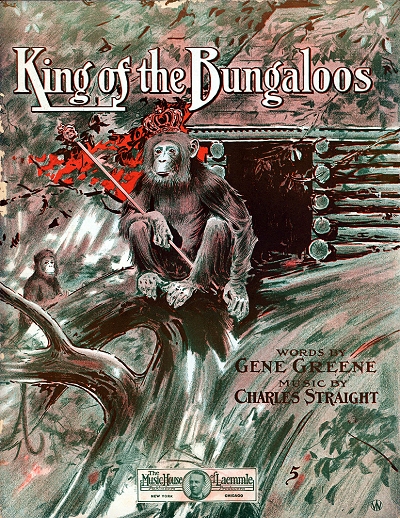 learning both classical and popular styles, and acting as an accompanist at times during his years at Wendell Philips High School.
learning both classical and popular styles, and acting as an accompanist at times during his years at Wendell Philips High School.
 learning both classical and popular styles, and acting as an accompanist at times during his years at Wendell Philips High School.
learning both classical and popular styles, and acting as an accompanist at times during his years at Wendell Philips High School.Upon graduation at 18, Charley managed to land a job with singer and comedian Gene Greene, at times billed as "The Ragtime King," and immediately set out with him on the Vaudeville circuit. With Gene he started composing as well. Their first published piece together, King of the Bungaloos, was a minor hit of some note, and represents perhaps the first recording by Charley on a record. It also features an early form of syllabic scat singing, where nonsense words or syllables are sung to accent the syncopations. Of some interest is that the piece was published by Carl Laemmle Sr., who in a few years would found Universal Studios. It can be ascertained, as was so often the case, that not all their material made it into print. One of the advantages of constant stage work is that the composer can try out something and quickly gauge reaction to it, making it easier to detect duds, and submitting for print the ones that work. A lot of their act was comprised of pieces composed by Greene and Straight. In 1912 Charley started publishing piano rags as well, one of his best known being the Mocking Bird Rag.
During his years with Greene, Charley got to see a bit of the world outside Chicago and the U.S. The pair are shown coming back from England in late 1913 after at least a couple of tours there where they had played a command performance for the King and Queen. Another arrival is seen in a manifest from an extended Australian trip back to San Francisco on March 7, 1914. While there, they performed for the Lord Mayor of Sydney and at the Tivoli Theatre in Melbourne,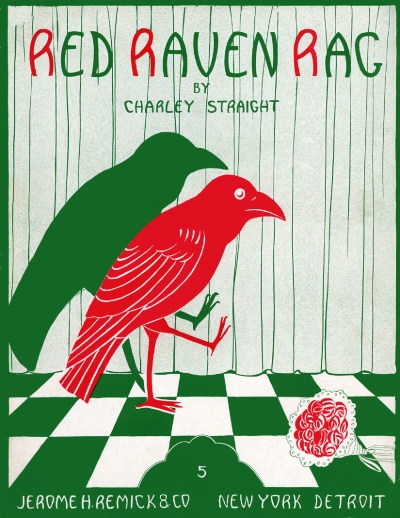 where Charley's accompaniments got notable reviews. Greene and Straight also recorded a reported 65 sides for Pathé Records during their time together, including King of the Bungaloos. After coming back from Australia, it appears that further travel was confined to the United States, as Charley had married Clara Kennedy on August 18, 1913, and the team of Greene and Straight more or less dissolved. The couple lived briefly in Manhattan in late 1913 into 1914 where he published songs and rags with two of the largest firms in the city, Jerome H. Remick & Company and M. Witmark & Sons. Charley also worked as a soloist around town while looking for another good opportunity. After a short excursion to Australia in the spring of 1914, the Straight's first daughter Virginia Marie was born on July 11 after they had moved back to Chicago.
where Charley's accompaniments got notable reviews. Greene and Straight also recorded a reported 65 sides for Pathé Records during their time together, including King of the Bungaloos. After coming back from Australia, it appears that further travel was confined to the United States, as Charley had married Clara Kennedy on August 18, 1913, and the team of Greene and Straight more or less dissolved. The couple lived briefly in Manhattan in late 1913 into 1914 where he published songs and rags with two of the largest firms in the city, Jerome H. Remick & Company and M. Witmark & Sons. Charley also worked as a soloist around town while looking for another good opportunity. After a short excursion to Australia in the spring of 1914, the Straight's first daughter Virginia Marie was born on July 11 after they had moved back to Chicago.
 where Charley's accompaniments got notable reviews. Greene and Straight also recorded a reported 65 sides for Pathé Records during their time together, including King of the Bungaloos. After coming back from Australia, it appears that further travel was confined to the United States, as Charley had married Clara Kennedy on August 18, 1913, and the team of Greene and Straight more or less dissolved. The couple lived briefly in Manhattan in late 1913 into 1914 where he published songs and rags with two of the largest firms in the city, Jerome H. Remick & Company and M. Witmark & Sons. Charley also worked as a soloist around town while looking for another good opportunity. After a short excursion to Australia in the spring of 1914, the Straight's first daughter Virginia Marie was born on July 11 after they had moved back to Chicago.
where Charley's accompaniments got notable reviews. Greene and Straight also recorded a reported 65 sides for Pathé Records during their time together, including King of the Bungaloos. After coming back from Australia, it appears that further travel was confined to the United States, as Charley had married Clara Kennedy on August 18, 1913, and the team of Greene and Straight more or less dissolved. The couple lived briefly in Manhattan in late 1913 into 1914 where he published songs and rags with two of the largest firms in the city, Jerome H. Remick & Company and M. Witmark & Sons. Charley also worked as a soloist around town while looking for another good opportunity. After a short excursion to Australia in the spring of 1914, the Straight's first daughter Virginia Marie was born on July 11 after they had moved back to Chicago.Back on his home turf and still employed by Remick, Charley dug in as a composer of songs and instrumentals. One piece in particular caught the ear of a Music Trade Review reporter in October, 1915: "Just to find out for ourselves what was doing, The Review reporter wandered over to Remick's, figuring that if there was anything exciting doing he'd find it there. Sure enough, there was a line three deep before the counter which 'Shorty' Stroubel and Charley Straight were trying to satisfy, and the piano rooms were all crowded and working as hard as they ever did. Speaking of Charley, that gentleman has just added to the Remick list a new fox-trot, which he has named 'Let's Go.' Into it Straight has put plenty of the snap that has characterized his playing, and which aided so much in popularizing American ragtime in Europe. Straight was one of the first of the American rag artists to descend upon the old world and teach it the beauties of ragged syncopation." He would also soon bring it into parlors everywhere.
It appears that Charley's first job cutting piano rolls was for the QRS Autograph Line, likely as early as the late fall of 1914 just after his return for New York, based on advertising. The Autographs were allegedly hand-played rolls in that they were played live on a marking piano, but then sometimes heavily edited before being made into a master for duplication and distribution. The kingpin of QRS at that time was Lee S. Roberts who had been there in the beginning. Charley would have arrived there a few months before Max Kortlander, who eventually took the company over in 1931, but until then had favored artist status. Whether due to a reason that was stylistic or artistic, or perhaps what Charley felt were unfavorable terms,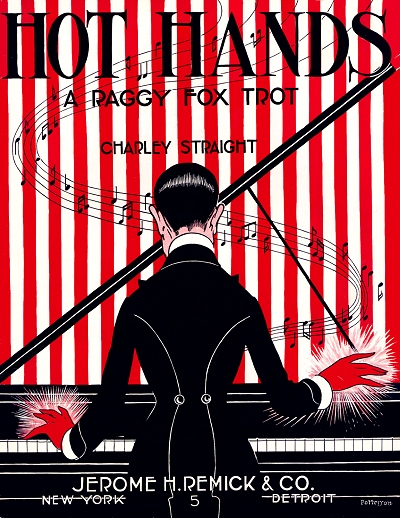 he stayed with QRS for only a year or so, having left around the end of 1915, probably having been on a one year contract.
he stayed with QRS for only a year or so, having left around the end of 1915, probably having been on a one year contract.
 he stayed with QRS for only a year or so, having left around the end of 1915, probably having been on a one year contract.
he stayed with QRS for only a year or so, having left around the end of 1915, probably having been on a one year contract.In early 1916 Charley moved over to Rolla Artis, a subsidiary of the Rudolph Wurlitzer Piano Company. While there he recorded under the name of Billy King (sometimes spelled as Billie). His May 1917 Draft record shows him supporting a wife and baby, and employed by New York publisher Waterson, Berlin & Snyder, who had a Chicago office. This suggests the possibility he may have been associated with them during his time in New York. That particular job may predate or coincide with his next important position, as at some point in 1917 he landed a job at the Imperial Piano Roll Company in Chicago, who had just lost one of their prime artists, Lewis J. Fuiks, to Ampico in New York City. There he would become famous as Victor Arden.
One of the first announcements of his employment appeared in the Music Trade Review of July 14, 1917: "Added to the Imperial list now is the work of Charlie Straight, a young fellow who can make the piano talk in any language that he wishes." In short order he was put in charge of their popular song series, arranging and playing his own rolls as well as arranging or editing those of other players. As if this achievement wasn't enough, he was also tapped by rival roll manufacturer QRS within a couple of years, contributing additional originals to them as well as more arrangements of popular songs, one of the few players to pull this feat off. On November 10, 1917, his second daughter, June Philomena, would come into the world.
The staff at Imperial was already quite renowned, including the highly talented Zema Randale who was in her early twenties. Charley and Zema performed a few duets together during her tenure at Imperial. Sadly, it ended in mid-April of 1918 when Randale died of diphtheria. Even before that time, Charley had quickly gained a reputation in the industry for making any performance his own. Shortly after he went to work for Imperial, Charley introduced a roll style called Banjo Rags, which used certain tricks to reproduce the tone of the banjo on a standard player piano, as outlined Music Trade Review of October 6, 1917:
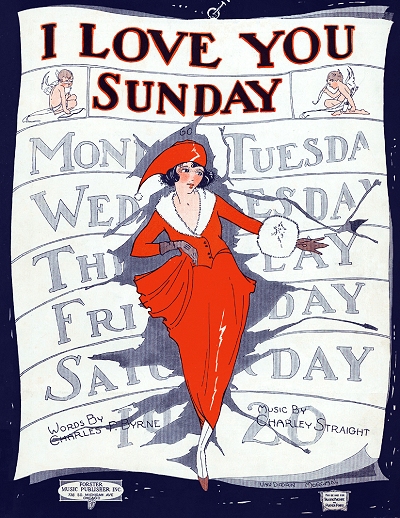 The Imperial Player Roll Co., of this city, which is credited with being the first to produce jazz rolls for player pianos, has apparently registered another hit with a new player roll production, the Banjo Rag. The new Banjo Rags are the work of Charley Straight, known as the Paderewski of ragtime, who is under an exclusive arrangement with the Imperial Co. In them he has found the opportunity to emphasize his unique musical ability to its fullest extent.
The Imperial Player Roll Co., of this city, which is credited with being the first to produce jazz rolls for player pianos, has apparently registered another hit with a new player roll production, the Banjo Rag. The new Banjo Rags are the work of Charley Straight, known as the Paderewski of ragtime, who is under an exclusive arrangement with the Imperial Co. In them he has found the opportunity to emphasize his unique musical ability to its fullest extent.In a recent interview with Mr. Straight he said: "I felt that I could find a banjo in the piano. I remembered a song hit of mine of several years ago, in which the basic notes for such an arrangement were present, but I could not at once recall the name of the particular number, nor could I remember exactly how the notes were arranged, which produced the effect I had in mind.
"After many days and many nights, I finally hit, in a rather accidental fashion, upon the combination which I sought, and then it was a comparatively easy matter to broaden the idea, which, by the way, I had originally hit upon in the old song, to fit the present requirements. After trying any number of song hits, I finally selected that scintillating melody, 'Back to Hawaii' as the medium for introducing the original Imperial Banjo Rag 'Songrecord.'"
Banjo Rags are well named for the banjo is present in every one and it cannot be mistaken. It is not slurred nor does it depend upon any particular trick for its presence. It is simply the result of unusual musical ability backed by the unique and exclusive reproducing process controlled by the Imperial Co. Every Banjo Rag is also a "Songrecord." In other words, the words are printed on the roll...
With the advent of jazz music taking over the country in 1917, it would not take long for Charley to pick up the style and apply it to his performances. It was either the trades or, more likely, Imperial that dubbed him as the "Imperial Jazz King."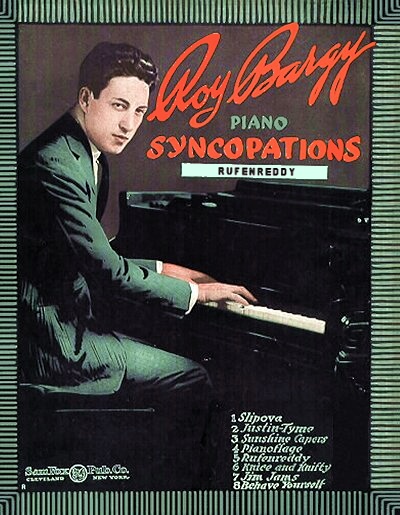 Straight could take the most mundane material and make it swing and shout. On more than one occasion this may have worked against him, if in a humorous manner, as reported in the Music Trade Review of March 30, 1918:
Straight could take the most mundane material and make it swing and shout. On more than one occasion this may have worked against him, if in a humorous manner, as reported in the Music Trade Review of March 30, 1918:
 Straight could take the most mundane material and make it swing and shout. On more than one occasion this may have worked against him, if in a humorous manner, as reported in the Music Trade Review of March 30, 1918:
Straight could take the most mundane material and make it swing and shout. On more than one occasion this may have worked against him, if in a humorous manner, as reported in the Music Trade Review of March 30, 1918:The Truth at Last
The trade along Piano Row have at last heaved a sigh of relief after spending an anxious two weeks or so in wondering what was the cause of the excitement around the Imperial Co.'s recording laboratories recently. Here's the answer: While Homer Rodeheaver, musical director of Billy Sunday, the famous evangelist, was personally interpreting the popular Sunday hymns which were played for Imperial Songrecords by Geo. Ashley Brewster, Manager Thomas Kavanaugh spent a few busy hours sitting on the neck of Charlie Straight, the Imperial jazz king. This was made necessary during the recording of these songs because Charlie had an idea that these hymns should have jazz accompaniments. As is well known these Sunday Songrecords are tremendous sellers, owing to their timeliness, and it is left to the trade to imagine for itself the demand these hymns would have created if Charlie had had his way.
Imperial was also exploiting Straight's emerging writing talent, offering some of his pieces on their label as performed by other artists, showing their universal appeal. As noted in the Music Trade Review of January 26, 1918, "Charley Straight's fame as a ragtime artist and composer has spread from Coast to Coast. Now comes a transition. Charley Straight makes his claim to fame as a ballad writer... He can tickle you and cheer you and make you long for the polished floor — but as a ballad writer he twangs the heart strings, wins you and holds you." This trend would nearly immediately be superseded by something more exciting.
From late 1917 through part of 1918, Straight commuted to New York for short stays, likely to deal with publishers and peers.
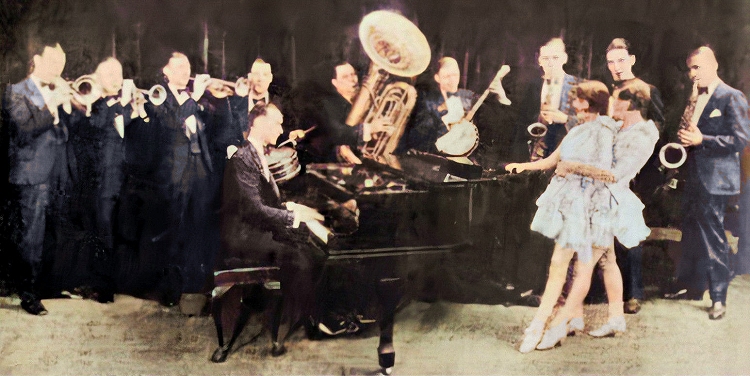 |
In 1919 the age of the novelty piano solo was just about underway. It was in this year that Straight auditioned the talented pianist Roy Bargy for a position at the firm. Bargy was asked to arrange a pop tune for piano roll. The initial cut was so good that Bargy was quickly hired and the tune was put into their catalog. Straight cultivated Roy's arranging abilities as he was assigned to record novelties and popular songs. He soon challenged Bargy to compose some of his own novelties in an effort to compete with rising star Zez Confrey of QRS. Bargy came back with six of the Eight Piano Syncopations that were every bit as innovative as Confrey's (with whom he became a long-time friend), but his pieces were not quite as accessible to the average pianist. The six were committed to piano rolls in 1920 and published as sheet music from the rolls two years later. Two others were written earlier by Straight, Rufenreddy and Knice and Knifty, and even committed to piano rolls in 1917 and 1918 respectively. However, Bargy got collaboration credit when they went to sheet music form.
This caused some confusion for many years as to the parentage of these two of the famous Eight Piano Syncopations, but it is clear that Straight was the original composer. It is likely that he wrote the bulk of the two compositions in 1917 and 1918, and that Bargy added many of his individual touches to them in his performances, the end result being that there is some of each of them within. It was Straight that introduced Bargy to booking agent, Edgar Benson, who had just formed a dance orchestra which was slated to record for Victor.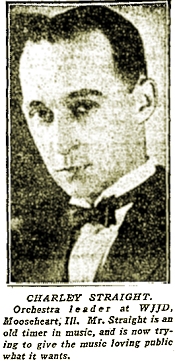 Benson was impressed by Bargy's skills and took him on as both pianist and musical director. In the 1920 census he listed himself as the manager of a piano firm, and was residing at 746 West Garfield Boulevard in Chicago about a mile west of Washington Park.
Benson was impressed by Bargy's skills and took him on as both pianist and musical director. In the 1920 census he listed himself as the manager of a piano firm, and was residing at 746 West Garfield Boulevard in Chicago about a mile west of Washington Park.
 Benson was impressed by Bargy's skills and took him on as both pianist and musical director. In the 1920 census he listed himself as the manager of a piano firm, and was residing at 746 West Garfield Boulevard in Chicago about a mile west of Washington Park.
Benson was impressed by Bargy's skills and took him on as both pianist and musical director. In the 1920 census he listed himself as the manager of a piano firm, and was residing at 746 West Garfield Boulevard in Chicago about a mile west of Washington Park.Charley also got the band bug, and in 1920, the same year he joined ASCAP, he started working and recording with his own group, the Charley Straight Orchestra. For the next several years his life consisted more or less of composing, arranging, performing and recording with his orchestra, and contributing piano roll arrangements from time to time.
His bosses tried to push the composing part, pulling a coup in September, 1919, when Imperial signed rising star lyricist Gustave "Gus" Kahn to their staff to write songs exclusively with Charley. While only a few ever emerged, it was a unique arrangement as they were often available on piano roll well before they were in sheet music form, a sales strategy that never gained too much traction. Kahn was soon a free agent again. As late as 1921 Straight and Bargy were also writing songs together and having them published by McKinley Music in Chicago. As lauded in the Music Trade Review that May, "Messrs. Straight and Bargy stand high among the popular pianists of the day and have reputations that extend from coast to coast through the fact that both record exclusively for the Imperial player rolls." This would not last much longer, however.
Straight announced his resignation from Imperial as of January 1, 1922, and most of his subsequent roll work was for industry giant QRS. His ensemble secured a long-term booking at the Rendezvous Café in Chicago, working there for much of 1922 to 1925 with occasional weekend appearances outside of town. Working with The Frisco Syncopators in late 1923, Straight and that group recorded 14 sides for the Paramount label, some of them now considered to be the white equivalent of the best hot jazz being played by black groups, such as the one led by Joseph "King" Oliver. Starting in 1924 Straight was heard on the radio with increasing frequency, both as a soloist and a bandleader.
In 1926 the band toured the Midwest for a while represented by the Music Corporation of America (MCA), including an engagement at the noteworthy Muehlbach Hotel in Kansas City, Missouri, where many other ragtime and early jazz luminaries had been featured. They were such a hit in Kansas City that their run was extended. It also garnered a mention in the Music Trade Review of July 24, 1926:
Popular Brunswick Recording Orchestra Has Engagement at Muehlbach Hotel Extended for Additional Period of Six Weeks
Charley Straight and His Orchestra, Brunswick recording artists, who some time ago signed a contract to play at the Muehlbach Hotel, Kansas City, for a period of six weeks, proved so distinctly popular with the hotel patrons that the management prevailed upon the orchestra to continue for an additional period of six
weeks.
The Kansas City branch of the Brunswick Co. took advantage of the orchestra engagement to place in the lobby of the Muehlbach a giant replica of a Brunswick record, five feet in diameter, informing the public that Charley Straight is a Brunswick artist and that any dealer will gladly play his records. A number of dealers also tied up with the orchestra by means of special window displays and direct mail campaigns with the result that an unusual volume of sales of records made by the orchestra was recorded.
Back in Chicago later in the year, Straight and the orchestra opened at the Midnight Frolics, an engagement that would have been a continuing success if not for the presence of bootleg liquor. As a result, Federal agents shut the place down in early 1928, reopening within a few months, with Straight's orchestra once again in place. From 1926 to 1928 the group also recorded a number of sides for Brunswick records, mostly of the "Hot Dance" music variety. More recordings were issued on the Vocalion label as well. In the 1930 census Charley and his daughters are shown, but now with a Sadie Straight at his side. It was Clara, who was still married to him at the time of his death, but why the name Sadie is used is unclear. Charley was listed as a theater musician.
The Straight Orchestra quit recording by 1929, and he was now long out of the piano roll business. However, Straight continued to perform with and without an orchestra throughout the 1930s and the Great Depression, including frequent radio dates. One of his more notable orchestra gigs was at the 1933/1934 fair, Chicago's Century of Progress, which garnered good reviews. They also had a steady run on the radio with WGN in the late 1930s, playing at occasional hotel dates as well. But work started to dry up for some of the older style bands during the swing era, and Charley's orchestra eventually lost favor. Even as of the April 1940 census, Charlie listed himself as an orchestra leader.
As a result of his forced retirement, Straight had to take a day job as a water sampler with the Metropolitan Sanitary District of Chicago. It was in this position in September 1940 at age 49 that he was struck and killed by a passing car while at a manhole, leaving Clara as a widow. The legacy he left behind was multi-faceted, having been a success as a piano roll artist, accompanist, composer, bandleader and recording artist, and importantly as an innovator in the novelty piano style. He has also been credited with being a leading force, along with Confrey, in the transition from ragtime to hot piano jazz.
Some of the recently uncovered information was put forward by the late Mike Meddings on his extraordinary site, www.doctorjazz.co.uk. Thanks also to Bryan Wright of Rivermont Records who helped in the discovery of Straight's earlier QRS rolls, and refinement of his mid-teens time line. The bulk of this biography comes from some original research, public and government records, periodicals, newspapers and established biographical information.